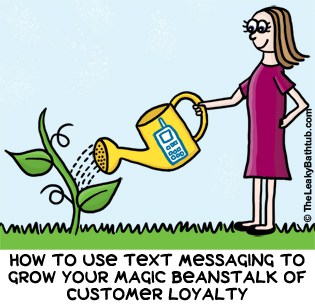
Since the first text message (or SMS: Short Message Service) was sent in 1992 in the UK, it’s become the most widely used data application in the world. In 2011 there were 3.6 billion active users, or 78% of all mobile phone subscribers. So yeah, text messaging is big!
(Facts ‘n’ figures are from Wikipedia: http://en.wikipedia.org/wiki/SMS)
However, text messaging as a marketing tool is a double-edged sword…
The great thing about using text messaging as a marketing tool is that just about everyone has a cell phone. And most people have their phone nearby all the time. Thus texting is a very personalised, instant way to communicate with people… and that’s what makes it a double-edged sword.
You see, that personal connection needs trust. When you send someone a text message, it’s quite an intimate form of communication. So it’s absolutely vital that you, as a marketer, respect this intimacy.
For example, many consumers won’t tolerate receiving lots of generic promotional text messages. (Some may be happy to, but I’d say that most folks would find it annoying to get lots of promotions on their phone by SMS.) That means that if you send promotional text messages to your customers, you need to be really sensitive about their preferences. If you don’t act sensitively, you could very easily upset and alienate clients and lose their custom and referrals. Eek!
So does this mean you should never use SMS in your business?
No, not at all… you just need to be careful about it!
You see, there are some text messages that people find helpful; and other messages are annoying. (Like the promotional messages I’ve already mentioned.)
What kind of text messages do people find helpful?
The most helpful kind of text message is a reminder. For example, my beauty therapist and hairdresser send me reminders of my appointments, and I have to reply to the text message to confirm them. These reminders are really handy for me, and if I ever forget what my appointment time is, I don’t even have to open up my calendar, I can just look at my text messages.
This reminder/confirmation system is hugely advantageous for the business owners, too. Many appointment-type businesses have a problem with “no shows”, i.e. people simply not turning up to their appointment, and without letting the business know. That means that the empty appointment can’t be offered to another customer, which means downtime, which means no income in that time period (whilst still paying staff wages and overheads), which means a loss of profit. Using a text message reminder/confirmation system can drastically improve no show rates.
In that scenario, text messaging doesn’t just help with customer retention; it can make a real, measurable difference to profitability – instantly.
Personalised messages can work well too
There are a few different ways to send personalised messages. Here are some examples… and if you’ve got any of your own, I’d love to hear them, just add a Comment to this blog (below).
- Birthday messages and promotions: If you capture clients’ birthdays, send them a congratulatory message on their special day. Businesses such as beauty therapists could even send them a special birthday offer, e.g. pop in this week and get a free manicure as a thank you for being a loyal customer. (If possible, tier the gifts so that they align with the customers’ spending levels, and better still, get them to try a new service – they may just love it and spend even more money with you in the future!)
- Congratulations: Has your client just appeared in a newspaper, or been on the radio? Or won an Award or run a marathon? Send them a text message to say “nice job”! It’s instant; it’s personal; and it’s great for those times when you’re not sure whether to call them on the phone or not. And because text messaging is so personal, this will probably get noticed more than an email would.
- Thanks: Maybe you’ve just had lunch with a client or strategic alliance partner. Or maybe a client came to your seminar or workshop. Send them a text message right away saying something like “Thanks for your time, it was great to catch up.” It’s thoughtful, polite and a good relationship builder. And it’s instant, too: you could say thanks in an email, but you don’t know when your contact will next be checking their emails. But they receive the text message right away.
How do you send the text messages?
Sending personal congratulatory or thank you messages is easy: you just whip out your phone, type and hit ‘send’.
But for anything more complex than that, e.g. birthday promotions, appointment reminders, and so on, it would be difficult to do manually. There are computer systems that can take care of that, and that are linked directly to your client database. (What kinds of systems? You’d need to do some research specific to your industry and to your country. A good place to start is by finding out what your competitors use.)
You also need systems to store clients’ communication preferences
Another reason why it’s a good idea to have a computer system take care of your text messaging is because you need to store your customers’ communication preferences. You see, text messaging (in most countries) is governed by anti-spam laws, similar to email marketing laws.
The smart business owner will have separate opt-in options for:
- Email newsletters
- SMS (text message) promotions
- Reminders
You see, it’s highly likely that you have to offer some way of letting clients unsubscribe from SMS (text message) promotions. (Check the laws that apply to your own country.) So imagine if you just had one opt-in list which covers ALL your client communications: you’d lose that subscriber completely! Yet in reality, that subscriber may not want to receive text message promotions, but they’re happy to receive emails and reminders.
Therefore the more flexible your opt-in options, the better it will be for your business.
Another problem with SMS promotions is that they’re expensive
Text messaging is a relatively expensive way to reach your clients: here in New Zealand, it’s usually 20 cents per 160-character message. If you have a big database, the costs can quickly add up.
If you do try sending promotions by text message, be sure to:
(a) Carry out a cost/benefit analysis beforehand, so you can identify how many responses are needed to break even on the campaign.
(b) If possible, do some split testing with 2 different offers, and track the popularity of each offer.
(c) Carry out post-campaign analysis, to see which offer performed better, and whether the campaign was worthwhile or not.
Should you use “txt language” in your messages?
Gosh it can be hard to fit everything you want to say into 160 characters! (Yes, it’s another of those double-edged sword issues with SMS!) So should you use SMS language?
- For example: Thank you for the meeting today, it was great to see you.
- Becomes: Thx 4 t mtg 2day it was gr8 2 c u.
My thoughts: Use words in full where you can. SMS language doesn’t project a professional image (leave it for messaging your buddies), plus it can be misunderstood far too easily.
For example, there are still lots of people who think that “LOL” stands for “Lots of love”. (In case you’re wondering, it actually stands for “Laugh out loud”.
So don’t risk any misunderstandings, and be clear in your communications by using proper language!
The future of text messaging
SMS has been around for a decade now, and let’s face it, we love being able to send and receive messages instantly, all over the world.
With smartphones being so popular, the technology we use for messaging may well evolve over time. For example, we may see more location-based features in the future. And the cost of messaging may become more affordable, with the ability to send longer messages and include graphics.
It’s certainly worth keeping an eye on what’s happening, because it’s a very exciting time to be a marketer!
Summary
- SMS (text messaging) is a very personal, intimate communications medium and you need to treat it with respect.
- Be helpful and be personal, rather than be too promotional.
- Reminder/confirmation messages are generally found to be useful by recipients – plus they can work wonders for your “no show” rate.
- Messages can either be sent manually, from your phone, or can be integrated with a specialised database.
- Be sure to observe the laws in your country regarding SMS marketing.
- Obtain opt-in consent (adhering to the laws in your country), and if possible split out the consent between different types of electronic communications (emails, SMS, reminders, etc.)
- If you send promotional text messages, be sure to test and measure your campaigns carefully to ensure they’re worthwhile.
- Avoid using shorthand “txt language” in your messages: it looks unprofessional, and can lead to misunderstandings.
- Cell phone technology is evolving rapidly, so keep an eye out for future trends and opportunities.



